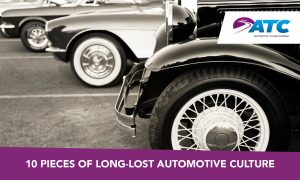
America of the 20th century was built around the automobile and it influenced just about every aspect of our lives. But sadly, there are some parts of our shared automotive car culture that are gone forever.
Take a trip back in time. Which of these aspects of automotive culture make you long for the “good old days?”
Hot Rods
After World War 2, returning GIs that gained mechanical skills while in the service started tinkering with inexpensive Model Ts and other cars from the 1920s through 1940s that were widely available. The goal was to create the fastest, coolest looking car and these souped-up hot rods created a customizing culture that gave birth to a huge automotive aftermarket industry.
Sadly, young people no longer spend hours customizing their cars; partially because they have become so complex, but also because their interests have changed.
Drive-Ins
People went car-crazy in the 40s and 50s, giving rise to the drive-in theater with its large outdoor screen, projection booth, concession stand and speakers that hung on the windows. There are still drive-ins, of course, but not nearly the same number as there used to be.
Tailfins
Tailfins began to appear on American cars in the late 1940s, and most people credit the 1948 Cadillac lineup for introducing them. The fins served no practical purpose but gave a Space Age look to cars and connected them to the technology that was capturing everyone’s attention at the time: jet planes and rockets. But as consumers’ tastes changed, tailfins disappeared.
Chrome
Sweet, beautiful chrome. 1950s and 1960s cars wore chrome like diamonds. The process of chrome plating had been perfected and chromed car parts were both brighter and lower maintenance than previous nickel-plated finishes, so car designers added chrome. And more chrome. And yet more chrome. Believe it or not, polishing the chrome used to be a weekend chore that some people loved!
Muscle Cars
The 1949 Oldsmobile Rocket 88 is often mentioned as the first muscle car. Putting a big engine in a small body was popular until skyrocketing insurance rates and smog control killed the muscle car in the early 1970s. But muscle cars have made a comeback with the re-introduction of the Dodge Charger, Chevy Camaro, and Ford Shelby Mustang.
Cruising
Just driving around town with friends might seem boring to today’s youth, but it was popular in the 50s, 60s, 70s, and 80s. Gas was cheap, the cars were cool, and memories of cruising spawned movies like “American Graffiti” and “Dazed and Confused.”
Whitewalls
Automotive tires were originally off-white in color, but when B.F. Goodrich added carbon black to the manufacturing process, they became the black tires we know today. But one small tire company only used the carbon black for the treads to cut costs. The result was a white tire with black treads. The look caught on and by the 1920’s whitewalls were mainstays on high end luxury cars. Whitewalls were popular in the 40s and 50s, but the size of the whitewall began to shrink in the 1960s, eventually disappearing completely.
Custom Vans
In the 1970s, full-size vans from Chevy, Ford and Dodge became the ultimate vehicles for self-expression. By the end of the decade, these “shag wagons” featured chrome side pipes, airbrushed murals, velvet interiors, and shag carpeting.
Conversion Vans
In the 1990s and 2000s, the full-size conversion van was incredibly popular. They featured luxury suspension, a high top which made the roof higher, swiveling captains’ chairs, custom lighting, and TVs with VCRs. All good things must come to an end, and the rise of the SUV killed the conversion van.
Vinyl Roofs
Vinyl roofs were originally created to make cars look like they were convertibles but became their own styling element. Vinyl roofs are considered hallmarks of 1970s American cars.
We’re sure we missed some aspects of car culture that we’ll never see again, but no matter what form or shape cars and trucks take, Automotive Titling Company (ATC) will provide the industry’s most accurate tax, title, and registration fee information to make the car buying experience easier for your shoppers and more profitable for dealers, lenders, and auto technology companies. We work with every DMV, in every jurisdiction in the country, to make it easier for you to sell cars. To learn more, contact us.




